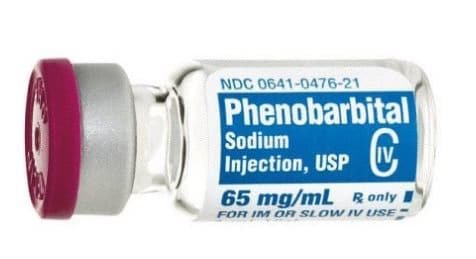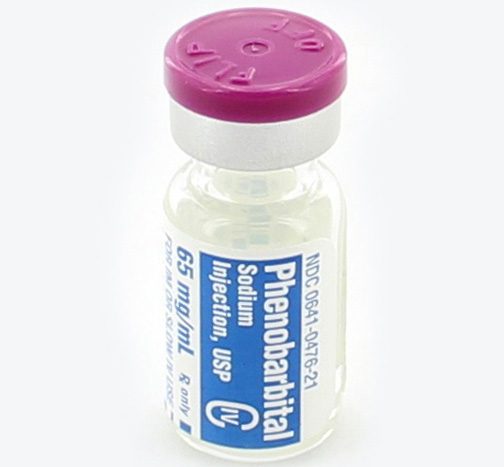
Phenobarbital (Phenobarbitalum, Luminal, Adonal, Aephenal, Barbenyl, Barbinal, Barbiphen, Dormiral, Epanal, Episedal, Fenemal, Fenobarbital, Gardenal, Hypnotal, Lepinal, Luminal, Mephabarbital, Neurobarb, Nirvonal, Omnibarb, Phenobarbitone, Sedonal, Sevenal, Somonal, Zadonal) is a strong long – acting barbiturate.
History of the discovery
Bayer released phenobarbital for sale in 1912 under the trade name Luminal. The new barbiturate was synthesized by the German chemist Emil Fischer in 1904, 2 years after the synthesis of the first barbiturate – barbital. Luminal remained a commonly used sedative and hypnotic until the advent of benzodiazepines in the 1950s.
Usually phenobarbital is considered as a sleeping pill. Indeed, it has a pronounced hypnotic effect and is used for sleep disorders. However, at present, this drug is of the greatest importance as an antiepileptic agent.
In small doses, phenobarbital has a calming effect and in combination with other drugs (antispasmodics, vasodilators) is used for neurovegetative disorders.
In connection with the anticonvulsant effect, phenobarbital is also prescribed for chorea, spastic paralysis, various convulsive reactions.
When taken orally, phenobarbital is completely absorbed, but relatively slowly. The peak concentration in the blood is observed 1-2 hours after administration. About 50% is bound by plasma proteins. The drug is evenly distributed in different organs and tissues; smaller concentrations of it are found in brain tissues. The half-existence period in the blood plasma in adults is 2-4 days (up to 7 days in newborns). It is released from the body slowly, which creates prerequisites for accumulation. It is metabolized by microsomal liver enzymes. The inactive metabolite (4-oxyphenobarbital) is excreted by the kidneys in the form of glucuronide, and about 25% – in unchanged form.

As a sleeping pill, phenobarbital is prescribed to adults at a dose of 0.1-0.2 g per reception, usually 1/2-1 hour before bedtime. The duration of the hypnotic effect is 6-8 hours. Children, depending on their age, are prescribed from 0.005 to 0.0075 g.
The hypnotic effect of phenobarbital is similar to that of other barbiturates. An undesirable property of phenobarbital is that when it is used, there may be a pronounced aftereffect: general depression, continued drowsiness, nystagmus, ataxia, etc.
As a sedative and antispasmodic agent, phenobarbital is prescribed in a dose 0,01-0,03-0,05 g 2-3 times a day. It is usually used in combination with antispasmodic, vasodilating and other drugs (tablets “Andipal”, “Bellataminal”, “Theophedrine”, etc.). It is part of the drugs corvalol and valocordin.
Long-term use of phenobarbital and drugs containing it as sleeping pills and sedatives should be avoided due to the possibility of their accumulation and the development of addiction.
Recently, a number of ready-made dosage forms containing phenobarbital (tablets “Pyraminal”, “Diaphein”, “Lupaverine”, “Theodinal”, “Microiod with phenobarbital”, etc.) have been excluded from the nomenclature of medicines.
For the treatment of patients with epilepsy, phenobarbital was first used in 1912 and is still considered one of the most effective antiepileptic drugs. It is widely used for generalized tonic-clonic seizures (grand mal), as well as for focal seizures in adults and children.
Adults are prescribed it, starting with a dose of 0.05 g 2 times a day and gradually increasing the dose until the seizures stop, but no more than 0.6 g per day. Children are prescribed the drug in smaller doses in accordance with age (not exceeding the highest single and daily doses). Treatment is carried out for a long time. It is necessary to stop taking phenobarbital for epilepsy gradually, since sudden withdrawal of the drug can cause the development of a seizure and even an epileptic status.
For the treatment of epilepsy, phenobarbital is often prescribed in combination with other medications. Usually, these combinations are selected individually, depending on the form and course of epilepsy and the general condition of the patient. There are, however, ready-made combined drugs (gluferal, pagluferal, falilepsin, etc.).
The Russian psychiatrist M. Ya. Sereisky proposed an extemparal combination (a mixture of Sereisky), which is still used to treat patients with epilepsy.
One of the properties of phenobarbital is its ability to cause the” induction ” of enzymes and enhance the activity of the monooxygenase enzyme system of the liver, which should be taken into account when it is used simultaneously with other drugs, the effect of which may be weakened at the same time (see Benzonal). The same feature of phenobarbital is associated with its ability to reduce hyperbilirubinemia, which is the basis of its use for the treatment and prevention of hemolytic disease of newborns.
When treating with phenobarbital, especially with prolonged use of it, side effects are possible, due not only to the suppression of the central nervous system, but also to a decrease in blood pressure, allergic reactions (skin rash, etc.), shifts in the blood formula.
The simultaneous use of phenobarbital with other sedative-acting drugs leads to an increase in the sedative-hypnotic effect and may be accompanied by respiratory depression.
Contraindications
The drug is contraindicated in severe liver and kidney damage with a violation of their functions, alcoholism, drug addiction, myasthenia gravis. It should not be prescribed in the first 3 months of pregnancy (in order to avoid teratogenic effects). It should also be borne in mind that in nursing mothers, when taking phenobarbital, it is found in significant quantities in milk.













